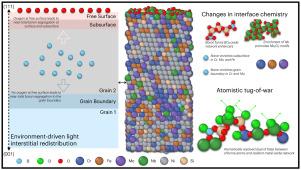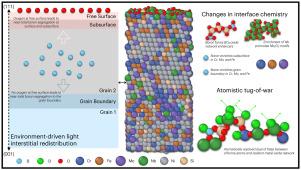Atomistic mechanisms of oxidation and chlorine corrosion in Ni-based superalloys: The role of boron and light interstitial segregation
IF 9.3
1区 材料科学
Q1 MATERIALS SCIENCE, MULTIDISCIPLINARY
引用次数: 0
Abstract
Hybrid Monte Carlo and molecular dynamics simulations were used to investigate the interaction of light interstitials in multi-element Ni-based alloys. We show that light interstitials such as boron and oxygen fundamentally alter interfacial chemistry by reshaping alloy-element distribution and segregation. Oxygen adsorption drove boron migration from the grain boundary to the free surface, where it co-enriched with Cr, Fe, and Mo and formed BO3 trigonal motifs embedded within mixed-metal oxide networks. Oxygen also promoted M![]() O
O![]() M chain formation, including Nb2O5 clusters at the free surface. In the absence of oxygen, boron segregated to the grain boundary, altering local metal chemistry and underscoring a dynamic, environment-sensitive behavior. Following chlorine exposure, the oxidized surfaces retained strong O-mediated connectivity while forming new Cl
M chain formation, including Nb2O5 clusters at the free surface. In the absence of oxygen, boron segregated to the grain boundary, altering local metal chemistry and underscoring a dynamic, environment-sensitive behavior. Following chlorine exposure, the oxidized surfaces retained strong O-mediated connectivity while forming new Cl![]() M associations, particularly with Nb and Cr, and exhibited further surface enrichment in Cr, Fe, and Mo. High-temperature MD simulations revealed a dynamic tug-of-war: chlorine exerted upward pull and disrupted weakly anchored sites, while Nb- and BO3-rich oxide motifs resisted deformation. A new stabilization mechanism was identified in which subsurface boron atoms anchored overlying Cr centers, suppressing their mobility and mitigating chlorine-driven displacement. These results demonstrate boron’s dual role as a modifier of alloy-element segregation and a stabilizer of oxide networks, and identify Nb as a key element in reinforcing cohesion under halogen attack. More broadly, this study highlights the need to track light interstitial cross-talk and solute migration under reactive conditions, offering atomistic criteria for designing corrosion-resistant surface chemistries in Ni-based superalloys exposed to halogenated or oxidative environments.
M associations, particularly with Nb and Cr, and exhibited further surface enrichment in Cr, Fe, and Mo. High-temperature MD simulations revealed a dynamic tug-of-war: chlorine exerted upward pull and disrupted weakly anchored sites, while Nb- and BO3-rich oxide motifs resisted deformation. A new stabilization mechanism was identified in which subsurface boron atoms anchored overlying Cr centers, suppressing their mobility and mitigating chlorine-driven displacement. These results demonstrate boron’s dual role as a modifier of alloy-element segregation and a stabilizer of oxide networks, and identify Nb as a key element in reinforcing cohesion under halogen attack. More broadly, this study highlights the need to track light interstitial cross-talk and solute migration under reactive conditions, offering atomistic criteria for designing corrosion-resistant surface chemistries in Ni-based superalloys exposed to halogenated or oxidative environments.


镍基高温合金中氧化和氯腐蚀的原子机制:硼和轻间隙偏析的作用
采用混合蒙特卡罗和分子动力学方法研究了多元素镍基合金中轻间隙的相互作用。我们发现,硼和氧等轻间隙通过重塑合金元素的分布和偏析,从根本上改变了界面化学。氧吸附驱动硼从晶界向自由表面迁移,在自由表面与Cr、Fe和Mo共富集,形成嵌入混合金属氧化物网络的BO3三角基序。氧也促进了M-O-M链的形成,包括自由表面的Nb2O5簇。在缺氧的情况下,硼向晶界分离,改变了当地的金属化学,并强调了一种动态的、对环境敏感的行为。在氯暴露后,氧化表面在形成新的Cl-M结合时保持了强的o介导的连连性,特别是与Nb和Cr形成了新的Cl-M结合,并表现出Cr、Fe和Mo的进一步表面富集。高温MD模拟揭示了一种动态的拉锯战:氯施加向上的拉力并破坏弱锚定位点,而富Nb和bo3的氧化物基元则抵抗变形。发现了一种新的稳定机制,即地下硼原子锚定在Cr中心上,抑制其迁移并减轻氯驱动的位移。这些结果证明了硼作为合金元素偏析的改进剂和氧化物网络的稳定剂的双重作用,并确定了铌是在卤素攻击下增强凝聚力的关键元素。更广泛地说,这项研究强调了在反应条件下跟踪光间隙串扰和溶质迁移的必要性,为设计暴露于卤化或氧化环境中的镍基高温合金的耐腐蚀表面化学提供了原子标准。
本文章由计算机程序翻译,如有差异,请以英文原文为准。
求助全文
约1分钟内获得全文
求助全文
来源期刊

Acta Materialia
工程技术-材料科学:综合
CiteScore
16.10
自引率
8.50%
发文量
801
审稿时长
53 days
期刊介绍:
Acta Materialia serves as a platform for publishing full-length, original papers and commissioned overviews that contribute to a profound understanding of the correlation between the processing, structure, and properties of inorganic materials. The journal seeks papers with high impact potential or those that significantly propel the field forward. The scope includes the atomic and molecular arrangements, chemical and electronic structures, and microstructure of materials, focusing on their mechanical or functional behavior across all length scales, including nanostructures.
 求助内容:
求助内容: 应助结果提醒方式:
应助结果提醒方式:


